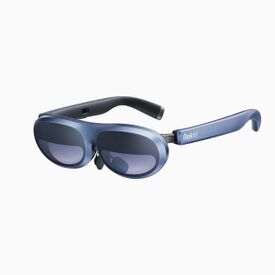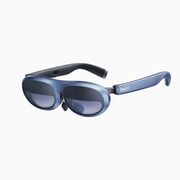Rokid Max Pro

| |
|---|---|
| Manufacturer | Rokid |
| Display | 2 x Micro-OLED |
| Resolution | 1920x1080 per-eye |
| Refresh Rate | 120 Hz |
| Image | |
| Visible FoV | 50° (diagonal) |
| Foveated Rendering | No |
| Optics | |
| Optics | Birdbath optics |
| Ocularity | Binocular |
| Passthrough | Native passthrough, greyscale camera |
| Tracking | 6 DoF Inside-out |
| Base Stations | No |
| Eye Tracking | No |
| Face Tracking | No |
| Hand Tracking | Yes |
| Body Tracking | No |
| Audio | Integrated stereo speakers |
| Microphone | Yes |
| 3.5mm Audio Jack | No |
| Ports | USB Type-C |
| Wired Video | DisplayPort via USB-C |
| Wireless Video | No |
| WiFi | No |
| Bluetooth | No |
| Material | Plastic |
| Headstrap | Glasses-style frame |
| Haptics | No |
| Color | Blue / grey |
The Rokid Max Pro is an augmented reality (AR) glasses product developed by Rokid. The product was launched in 2023. The marketing for the product includes the idea that they can offer a wearable monitor experience, projecting a virtual screen in front of the user. They have gained attention for their low price and their marketing as an AR and personal display device.
Development and Release[edit]
Rokid developed the Rokid Max as a successor to its earlier AR models.
Design and Features[edit]
Physical Design[edit]
The Rokid Max AR Glasses feature a lightweight design, weighing approximately 75 grams. They are equipped with two Micro-OLED displays, which project images using a bird bath optics system. This design choice is intended to reduce eye strain by reflecting the image to the wearer's line of sight, rather than directly projecting onto the eyes.
Diopter Adjustment[edit]
A distinctive feature of the Rokid Max is the inclusion of adjustable diopters. These allow users with near-sightedness to modify the focus of the lenses, eliminating the need for additional prescription lens inserts. This feature makes the Rokid Max more accessible to a wider range of users.
Audio[edit]
The glasses include directional speakers, designed to provide a more immersive audio experience while being audible primarily to the wearer. Reviewers have noted these speakers as superior in comparison to other AR glasses on the market.
Technical Specifications[edit]
The Rokid Max AR Glasses offer a 215-inch virtual screen experience, viewed from a 20-feet distance, to simulate an immersive viewing environment. The glasses do not have internal storage or battery, relying instead on a connected smart device for power and content. They support USB-C connectivity for a wide range of devices, including smartphones, tablets, and laptops.
User Experience[edit]
Visual Performance[edit]
The Rokid Max has been praised for its bright, colorful picture quality, with a wide field of view of 50 degrees. The Micro-OLED displays are noted for their clarity and vividness, making them suitable for various multimedia applications.
Comfort and Usability[edit]
Comfort has been a highlighted aspect, with the glasses being considered suitable for extended use. The adjustable diopters and lightweight design contribute significantly to user comfort.
Augmented Reality Applications[edit]
While positioned as AR glasses, the Rokid Max's augmented reality features are limited. The focus is more on providing a private, portable screen experience rather than interactive AR functionalities.
Market reception and reviews[edit]
The Rokid Max has received generally positive reviews from technology critics and users. It has been praised for its visual quality, comfort, and the inclusion of focus adjustment dials. However, it has also faced criticism for its limited AR capabilities and the physical design, which some users find less aesthetically pleasing.
Comparisons with competitors[edit]
In comparison to similar products like the TCL NXTWear S and Viture One, the Rokid Max stands out for its wider field of view and focus adjustments. However, its AR capabilities are considered less advanced than some of its competitors.
Price and value[edit]
The glasses are priced at around $439, placing them in the higher range of the market for AR glasses. While considered somewhat expensive, the unique features like diopter adjustments and superior speaker quality add to its perceived value.
Compatibility and Connectivity[edit]
The Rokid Max is compatible with devices that support DisplayPort over USB-C, including many modern laptops and smartphones. It also supports additional adapters for devices without USB-C DisplayPort, like certain game consoles and PCs.
Use Cases[edit]
The primary use cases for the Rokid Max include media consumption, such as watching movies and playing games, and as a secondary screen for laptops, enhancing ergonomics and posture during work. While its AR features are limited, the glasses serve well as a personal, portable display.
Images[edit]
- Rokid max pro2.jpg
- Rokid max pro4.jpg
- Rokid max pro5.jpg
- Rokid max pro6.jpg
- Rokid max pro3.jpg
